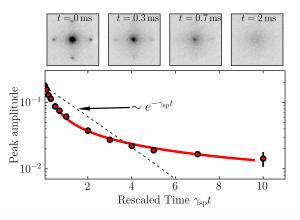Anomalous decay of coherence in a dissipative many-body system
Bose-Einstein condensates team of our lab study the loss of spatial coherence of bosonic atoms in an optical lattice when subjected to a controlled amount of spontaneous emission. Ytterbium atoms are promoted to an excited state by a near-resonant laser and decay back to the ground state by spontaneous emission. A non-interacting system would correspond to the textbook example of radiative decay, and to an exponential decay in time of the spatial coherence.
Our work shows that strong interactions drastically modify the picture and lead to a slowing down of the decoherence process associated with a universal power-law decay.
Link to the full article : https://www.nature.com/articles/s41567-019-0678-2

Top row: several images showing the atomic momentum distribution for several evolution times. Initially, the atoms form a Bose-Einstein condensate (BEC). When trapped by an optical lattice, the BEC momentum distribution displays a Bragg-like interference pattern showing spatially extended phase coherence. Spontaneous emission progressively destroys phase coherence, and the momentum distribution evolves towards a broad distribution without any Bragg features. The main panel shows that this decay occurs as a power law (solid line) for an interacting system. This contrast with the familiar exponential decay expected for independent atoms, shown as dashed line.
